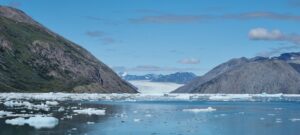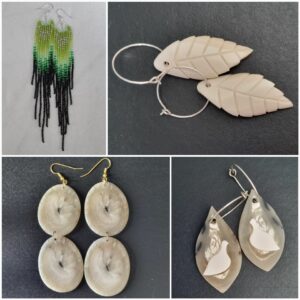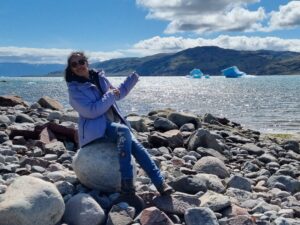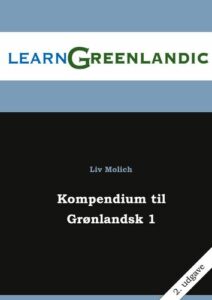Liv Molich has a website: Learn Greenlandic. There is an accompanying printed workbook Kompendium til Grønlandsk 1 2. This workbook is written in Danish and is thus by default directed specifically to the Danish speaking readership. However, I choose to write this review in English because a wider audience should take notice of it.
Liv Molich’s Kompendium is just that: a workbook accompaniment to a language course. It makes no claim to be anything else. However, the 97 A4 pages can in fact be read on their own and the workbook is remarkably self-contained. Add in the QR-code links to digital resources, and it is a full language course for the beginner in its own right. I chose to read right through this workbook without signing up for anything extra, and found that it serves as an introductory learning tool on its own.

There are several points that I find highly recommendable and that I think any designer of L2 material should take note of. For one, it addresses the non-linguist, but in such a way that the linguist finds meaningful data in it (and I have myself just gleaned new datapoints to my own typological datasets through this workbook alone). You do not need any background knowledge at all to be able to make use of and understand this workbook. For another, in the few pages it has at its disposal, it lets you go from knowing not a single word of Greenlandic, to being able to introduce yourself at a kaffillerneq (kaffemik), and take part in both birthday celebrations and speak about upcoming plans. And it lets you travel that journey without inundating you with abstract morphosyntactic notions and terminology despite the highly polysynthetic nature of this language. In fact, the approach of simply diving into the language in a form of written word immersion, while at the same time gradually bringing up linguistic notions, all of which are explained without resorting to impenetrable jargon, leaves the reader wanting to find out more, rather than feeling overwhelmed.
This brings me to another point of applause. Greenlandic is a language that has long been treated as an impossibly quirky and amusingly complicated language. The inevitable unfamiliarity a Danish speaker would feel with the structure of Greenlandic is addressed in the most inclusive and empathetic way I have hitherto seen. Neither the confusion of the Danish speaker nor the structure of the Greenlandic language is ridiculed or quirkified. Instead the points of differences are simply explained. Other points of common quirkifications, such as the potential length of Greenlandic words or the many words for different kinds of ‘snow’ are addressed, but without any kind of the usual sensationalism. On the contrary, the reader is simply shown the logic of it.

The short texts and the various exercises are embedded culture notes. Work through this book and you already feel you’ve visited Greenland and made friends there. The second half of the book consists of supporting material: terminological glossary, a mini dictionary, a mini grammar, an overview of the most important sound rules, a large set of paradigms and the exercise keys. This is what makes the workbook so self-contained. Between the actual workbook sections and the supporting material is a short, highly accessible, overview of the history of Greenland.
However, the book is dotted with QR-codes, as mentioned above, with direct links to material put out by Oqaasileriffik (the combined outlet for Oqaasiliortut/The Greenland Language Council and Nunat Aqqinik Aalajangiisartut/The Greenland Place Names Committee). The material made freely available is nothing short of breath-taking. We get access to word analysers and generators (which give us the morphological deep structure of words), corpora and word databases, dictionaries and spellcheckers, IPA converters and orthographical converters (between the Kleinschmidt spelling and the new spelling), real time analyses and Martha, the text-to-speech system. I gained access to these just through the QR code. However, if you go to https://oqaasileriffik.gl/ (available in Greenlandic, Danish and English), you’ll get access to much, much more – too much to list in this review – that is mouth-watering for interested the lay person and the specialist.
LearnGreenlandic Online has also made their L2 Grønlandsk for voksne module 1 and 2 material available for free spanning 2022-2027 (available at: https://learngreenlandic.com/). It targets the Danish speaker.

I can’t think of much to quibble about with respect to this workbook. It is by necessity a written mode learning tool, but it gives links to supporting pronunciation help. It is an accompanying workbook of just under 100 pages which functions on its own and leaves you wanting more – this is no mean feat. The only limitation is that it is only accessible to the Danish reader. My recommendation would be to also translate the material into English, in order to cater for a wider audience. And I would recommend any developer of L2 material to use this Kompendium as an inspiration.
Kompendium til Grønlandsk 1

98 pages. bod.dk
ISBN: 9788743045588
Viveka Velupillai is Honorary Professor at the Department of English at the University of Giessen, Germany, but is based in Shetland, where her principal project is to document and describe Shaetlan, the Contact Language spoken on the islands alongside English, in a typological perspective. Her specialities include linguistic typology, contact linguistics and historical linguistics. She is particularly interested in the interaction of language, place and the environment, and the effect of linguistic diversity on economic resilience and environmental sustainability. She is also interested in the effects of digitalk in giving written voices and growing acceptability to stigmatised and marginalised languages.








The first sentence “Liv Molich has a website: Learn Greenlandic.” is unfortunately misleading. The website is owned, developed, and run by Per Langgård, and the DVDs and whole Online part is Per’s work. Liv has her own company offering personal courses which uses the same website, and until a few years ago it was all the same company so there is a lot of overlap, but a reformulation is needed.